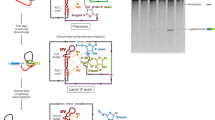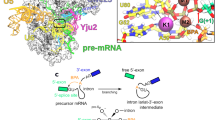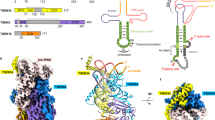Abstract
The removal of intervening sequences from premessenger RNA is essential for the expression of most eukaryotic genes. The spliceosome ribonucleoprotein complex catalyses intron removal by two sequential phosphotransesterification reactions1, but the catalytic mechanisms are unknown. It has been proposed that two divalent metal ions may mediate catalysis of both reaction steps, activating the 2′- or 3′-hydroxyl groups for nucleophilic attack and stabilizing the 3′-oxyanion leaving groups by direct coordination2. Here we show that in splicing reactions with a precursor RNA containing a 3′-sulphur substitution at the 5′ splice site, interaction between metal ion and leaving group is essential for catalysis of the first reaction step. This establishes that the spliceosome is a metalloenzyme and demonstrates a direct parallel with the catalytic strategy used by the self-splicing group I intron from Tetrahymena3. In contrast, 3′-sulphur substitution at the 3′ splice site provides no evidence for a metal ion–leaving group interaction in the second reaction step, suggesting that the two steps of splicing proceed by different catalytic mechanisms and therefore in distinct active sites.
This is a preview of subscription content, access via your institution
Access options
Subscribe to this journal
Receive 51 print issues and online access
$199.00 per year
only $3.90 per issue
Buy this article
- Purchase on Springer Link
- Instant access to full article PDF
Prices may be subject to local taxes which are calculated during checkout






Similar content being viewed by others
References
Krämer, A. in Pre-mRNA Processing(ed. Lamond, A.) 35–64 (Landes, Austin, (1995)).
Steitz, T. A. & Steitz, J. A. Ageneral two-metal-ion mechanism for catalytic RNA. Proc. Natl Acad. Sci. USA 90, 6498–6502 (1993).
Piccirilli, J. A., Vyle, J. S., Caruthers, M. H. & Cech, T. R. Metal ion catalysis in the Tetrahymena ribozyme reaction. Nature 361, 85–88 (1993).
Cosstick, R. & Vyle, J. S. Synthesis and properties of dithymidine phosphate analogues containing 3′-thiothymidine. Nucleic Acids Res. 18, 829–835 (1990).
Jaffe, E. K. & Cohn, M. Divalent cation-dependent stereospecificity of adenosine 5′-O-(2-thiotriphosphate) in the hexokinase and pyruvate kinase reactions: The absolute stereochemistry of the diastereomers of adenosine 5′-O-(2-thiotriphosphate). J. Biol. Chem. 253, 4823–4825 (1978).
Jaffe, E. K. & Cohn, M. Diastereomers of the nucleoside phosphorothioates as probes of the structure of the metal nucleotide substrates and of the nucleotide binding site of yeast hexokinase. J. Biol. Chem. 254, 10839–10845 (1979).
Pecoraro, V. L., Hermes, J. D. & Cleland, W. W. Stability constants of Mg2+ and Cd2+ complexes of adenine nucleotides and thionucleotides and rate constants for formation and dissociation of MgATP and MgADP. Biochemistry 23, 5262–5271 (1984).
Sigel, R. K. O., Song, B. & Sigel, H. Stabilities and structures of metal ion complexes of adenosine 5′-O-thiomonophosphate (AMPS2−) in comparison with those of its parent nucleotide (AMP2−) in aqueous solution. J. Am. Chem. Soc. 119, 744–755 (1997).
Moore, M. J. & Sharp, P. A. Site-specific modification of pre-mRNA: The 2′-hydroxyl groups at the splice sites. Science 256, 992–997 (1992).
Solnick, D. Trans splicing of mRNA precursors. Cell 42, 157–164 (1985).
Pearson, R. G. Acids and bases. Science 151, 172–177 (1966).
Dantzmann, C. L. & Kiessling, L. L. Reactivity of a 2′-thio nucleotide analog. J. Am. Chem. Soc. 118, 11715–11719 (1996).
Burgin, A. B., Huizenga, B. N. & Nash, H. A. Anovel suicide substrate for DNA topoisomerases and site-specific recombinases. Nucleic Acids Res. 23, 2973–2979 (1995).
Seiwert, S. D. & Steitz, J. A. Uncoupling two functions of the U1 small nuclear ribonucleoprotein particle during in vitro splicing. Mol. Cell. Biol. 13, 3135–3145 (1993).
Vyle, J. S., Connolly, B. A., Kemp, D. & Cosstick, R. Sequence- and strand-specific cleavage in oligodeoxyribonucleotides and DNA containing 3′-thiothymidine. Biochemsitry 31, 3012–3018 (1992).
Weinstein, L. B., Earnshaw, D. J., Cosstick, R. & Cech, T. R. Synthesis and characterization of an RNA dinucleotide containing a 3′-S-phosphorothiolate linkage. J. Am. Chem. Soc. 118, 10341–10350 (1996).
Konarska, M. M. & Sharp, P. A. Electrophoretic separation of complexes involved in the splicing of precursors to mRNAs. Cell 46, 845–855 (1986).
Reyes, J. L., Kois, P., Konforti, B. B. & Konarska, M. M. The canonical GU dinucleotide at the 5′ splice site is recognized by p220 of the U5 snRNP within the spliceosome. RNA 2, 213–225 (1996).
Narlikar, G. J., Gopalakrishnan, V., McConnell, T. S., Usman, N. & Herschlag, D. Use of binding energy by an RNA enzyme for catalysis by positioning and substrate destabilization. Proc. Natl Acad. Sci. USA 92, 3668–3672 (1995).
Aebi, M., Hornig, H., Padgett, R. A., Reiser, J. & Weissmann, C. Sequence requirements for splicing of higher eukaryotic nuclear pre-mRNA. Cell 47, 555–565 (1986).
Tarn, W.-Y. Site-specific substitution of inosine at the terminal positions of a pre-mRNA intron: Implications for the configuration of the terminal base interaction. Biochimie(in the press).
Anderegg, G. in Comprehensive Coordination Chemistry: The Synthesis, Reactions, Properties and Applications of Coordination Compounds(eds Wilkinson, G., Gillard, R. D. & McCleverty, J. A.) 777–792 (Pergamon, Oxford, (1987)).
Freemont, P. S., Friedman, J. M., Beese, L. S., Sanderson, M. R. & Steitz, T. A. Cocrystal structure ofanediting complex of Klenow fragment with DNA. Proc. Natl Acad. Sci. USA 85, 8924–8928 (1988).
Moore, M. J. & Sharp, P. A. Evidence for two active sites in the spliceosome provided by stereochemistry of pre-mRNA splicing. Nature 365, 364–368 (1993).
Sontheimer, E. J. & Steitz, J. A. The U5 and U6 small nuclear RNAs as active site components of the spliceosome. Science 262, 1989–1996 (1993).
Query, C. C., Moore, M. J. & Sharp, P. A. Branch nucleophile selection in pre-mRNA splicing: evidence for the bulged duplex model. Genes Dev. 8, 587–597 (1994).
Dignam, J. D., Lebovitz, R. M. & Roeder, R. G. Accurate transcription initiation by RNA polymerase II in a soluble extract from isolated mammalian nuclei. Nucleic Acids Res. 11, 1475–1489 (1983).
Abmayr, S. M., Reed, R. & Maniatis, T. Identification of a functional mammalian spliceosome containing unspliced pre-mRNA. Proc. Natl Acad. Sci. USA 85, 7216–7220 (1988).
Acknowledgements
We thank M. Hamm and L. Munishkina for oligonucleotide synthesis, W.-Y. Tarn for communicating unpublished results, members of our laboratory for advice and discussions, and J.Curley, M. Hamm and A. Yoshida for comments on the manuscript. E.J.S. was supported in part by a postdoctoral fellowship from the Jane Coffin Childs Memorial Fund for Medical Research. E.J.S. and S.S. are research associates and J.A.P. is an assistant investigator of the Howard Hughes Medical Institute.
Author information
Authors and Affiliations
Author notes
Correspondence and requests for materials should be addressed to J.A.P.
Rights and permissions
About this article
Cite this article
Sontheimer, E., Sun, S. & Piccirilli, J. Metal ion catalysis during splicing of premessenger RNA. Nature 388, 801–805 (1997). https://doi.org/10.1038/42068
Received:
Accepted:
Issue Date:
DOI: https://doi.org/10.1038/42068
This article is cited by
-
Mechanistic insights into precursor messenger RNA splicing by the spliceosome
Nature Reviews Molecular Cell Biology (2017)
-
A conformational switch in PRP8 mediates metal ion coordination that promotes pre-mRNA exon ligation
Nature Structural & Molecular Biology (2013)
-
Metal ghosts in the splicing machine
Nature (2013)
-
RNA catalyses nuclear pre-mRNA splicing
Nature (2013)
-
A metal switch for controlling the activity of molecular motor proteins
Nature Structural & Molecular Biology (2012)
Comments
By submitting a comment you agree to abide by our Terms and Community Guidelines. If you find something abusive or that does not comply with our terms or guidelines please flag it as inappropriate.



